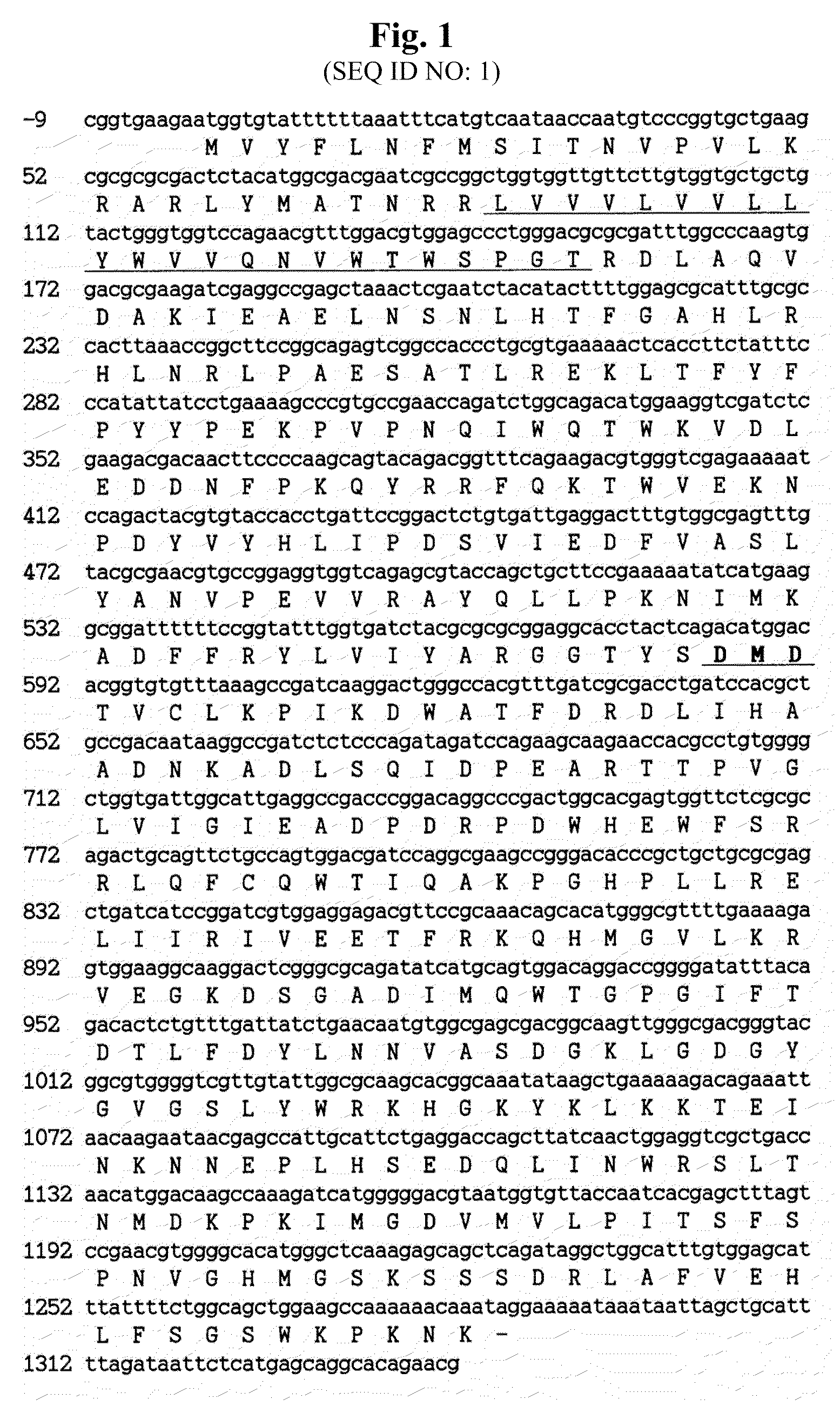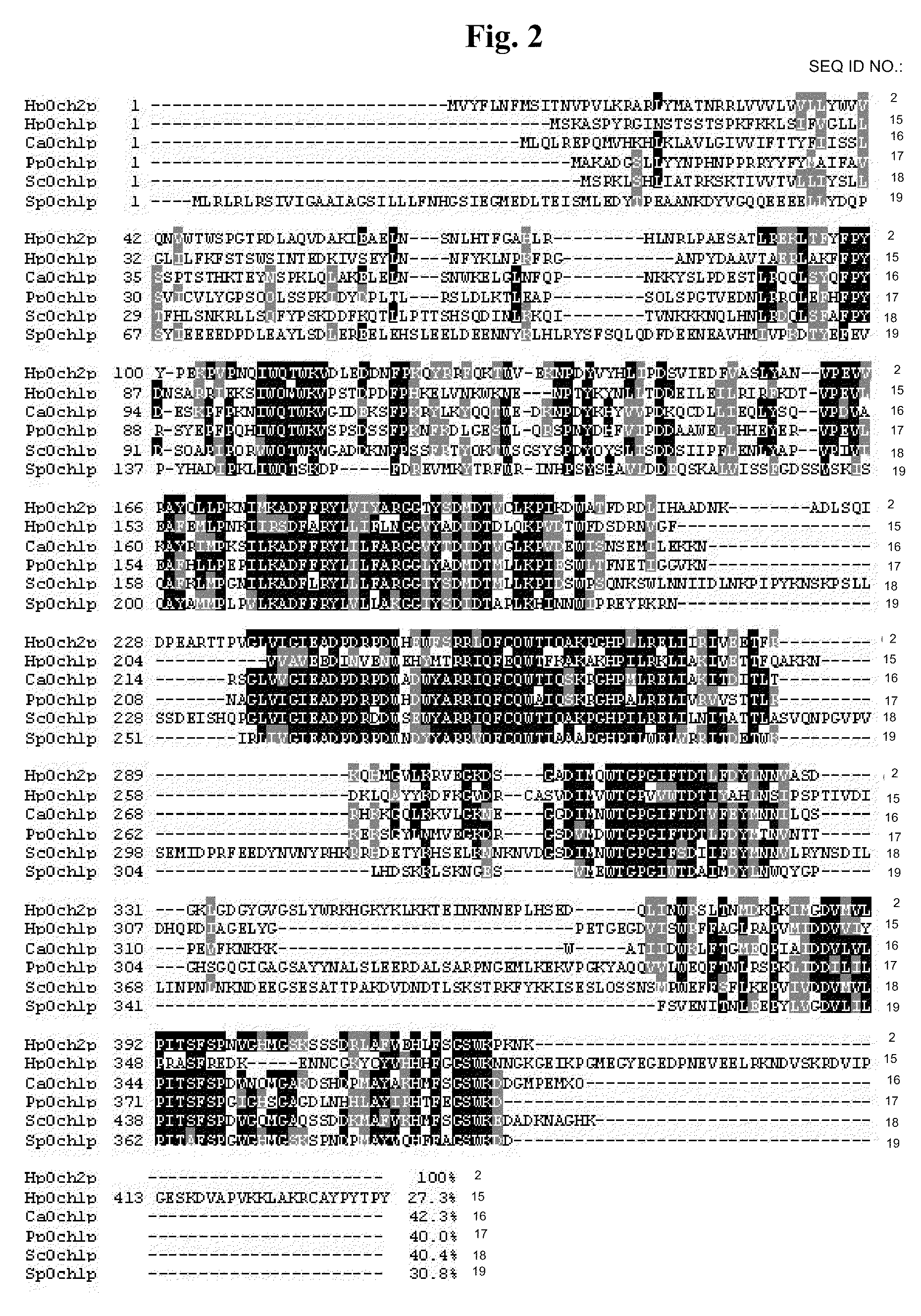Hansenula polymorpha gene coding for α 1,6-mannosyltransferase and process for the production of recombinant glycoproteins with Hansenula polymorpha mutant strain deficient in the same gene
a technology of hansenula polymorpha and hansenula polymorpha, which is applied in the direction of transferases, instruments, peptides, etc., can solve the problems of high cost, low yield, and expensive culture media
- Summary
- Abstract
- Description
- Claims
- Application Information
AI Technical Summary
Benefits of technology
Problems solved by technology
Method used
Image
Examples
example 1
Identification of Hansenula polymorpha HpOCH2 Gene and Analysis of the Amino Acid Sequence of the Gene
[0040]From the recently completed sequence of Hansenula polymorpha RB11 genome (Ramezani-Rad et al., FEMS Yeast Res., 4, 207-215 (2003)), whole sequences of ORFs (open reading frames) having a high similarity with the OCH1 gene family involved in outer chain biosynthesis of Saccharomyces cerevisiae were obtained. FIG. 9 shows amino acid sequence identity and similarity between Och1 protein homologues of H. polymorpha and S. cerevisiae, wherein the amino acid sequence identity and similarity between ORF168 and ScOch1p are represented by shaded bold numerals.
[0041]In the present invention, for functional analysis of the ORF168 gene having a 40% amino acid identity and a 54% amino acid similarity with S. cerevisiae OCH1 gene (ScOCH1) (Jungman and Munro, Embo J. 17, 423 (1998)) that plays a critical role in α-1,6-mannose addition at the early stage of outer chain biosynthesis of S. cere...
example 2
Establishment of H. polymorpha HpOCH2 Gene-Deficient Strain and Analysis of Characteristics of the Strain
[0043]To establish a H. polymorpha HpOCH2 gene-deficient mutant strain, gene disruption was performed by a combination of fusion PCR and in vivo DNA recombination (Oldenburg et al., Nucleic Acid Res., 25, 451, (1997)). Fusion PCR was carried out using primers (primers used for PCR for cloning and disruption of HpOCH2 gene) listed in Table 1, below. By primary PCR, 5′ and 3′ regions of URA3 gene and HpOCH2 gene were obtained. By secondary fusion PCR, the 5′ region of HpOCH2 gene was linked to the 5′ region of URA3 gene, and the 3′ region of URA3 gene was liked to the 3′ region of HpOCH2 gene. Then, the two DNA fragments were introduced into a yeast cell, and transformants having an HpOCH2 gene disrupted by in vivo DNA recombination were selected (FIG. 3). Primarily, using an URA3 selection marker, transformants grown in a minimum medium lacking uracil were selected. Then, amplifie...
example 3
Analysis of Size Distribution and Structure of Sugar Chains on a Glycoprotein Synthesized in the H. polymorpha Hpoch2Δ Mutant
[0045]To analyze the size distribution and structure of sugar chains on glycoprotein synthesized in the H. polymorpha Hpoch2Δ mutant prepared in Example 2, a glycoprotein derived from Aspergillus niger, glucose oxidase (GOD), was expressed in a secreted form in a H. polymorpha wild type and the Hpoch2Δ mutant. The glycoprotein, GOD, has eight putative amino acid sequences for N-linked glycosylation (Frederick et al., J. Biol. Chem., 265, 3793 (1990)). The H. polymorpha wild type and Hpoch2Δ mutant were individually transformed with an expression vector pDLMOX-GOD(H) expressing GOD with a six-histidine tag (Kim et al., Glycobiology (2004)), and were grown in YPM medium (1% yeast extract, 2% peptone, 2% methanol) supplemented with 2% methanol to express GOD. GOD secreted to the culture medium was passed through a nickel column to selectively isolate only GOD tag...
PUM
| Property | Measurement | Unit |
|---|---|---|
| temperature sensitivity | aaaaa | aaaaa |
| temperature sensitivity | aaaaa | aaaaa |
| α-1,6-mannosyltransferase activity | aaaaa | aaaaa |
Abstract
Description
Claims
Application Information
 Login to View More
Login to View More - R&D Engineer
- R&D Manager
- IP Professional
- Industry Leading Data Capabilities
- Powerful AI technology
- Patent DNA Extraction
Browse by: Latest US Patents, China's latest patents, Technical Efficacy Thesaurus, Application Domain, Technology Topic, Popular Technical Reports.
© 2024 PatSnap. All rights reserved.Legal|Privacy policy|Modern Slavery Act Transparency Statement|Sitemap|About US| Contact US: help@patsnap.com










